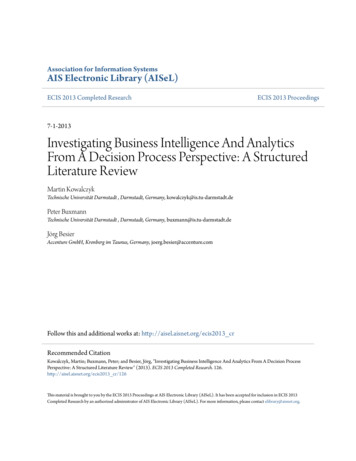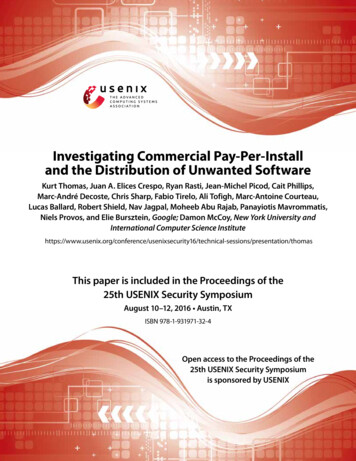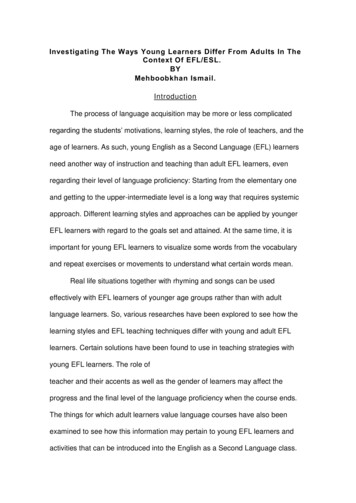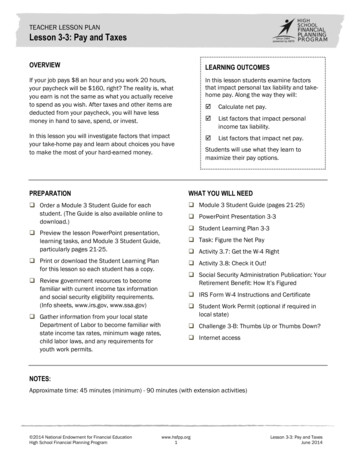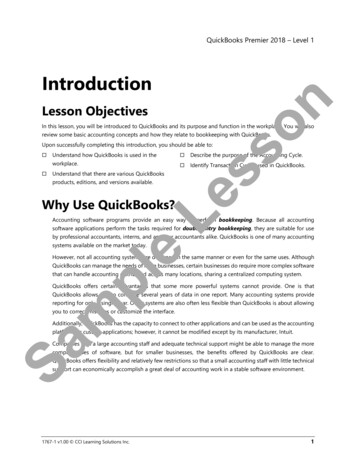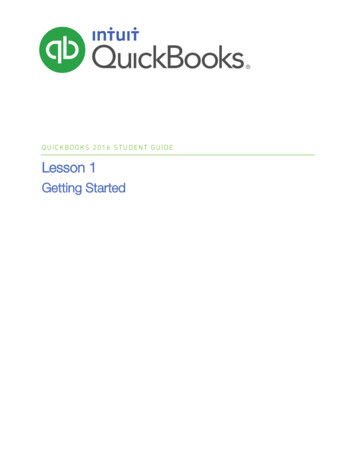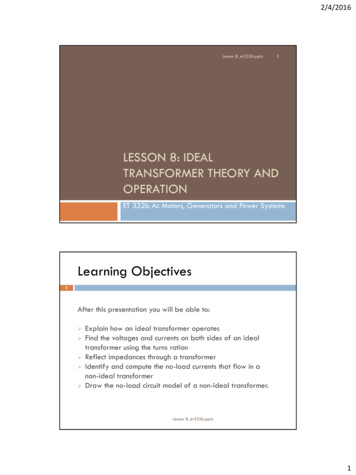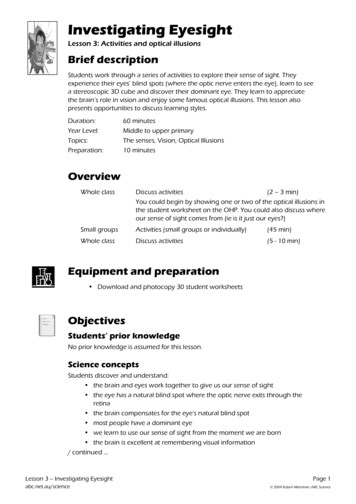
Transcription
Investigating EyesightLesson 3: Activities and optical illusionsBrief descriptionStudents work through a series of activities to explore their sense of sight. Theyexperience their eyes’ blind spots (where the optic nerve enters the eye), learn to seea stereoscopic 3D cube and discover their dominant eye. They learn to appreciatethe brain’s role in vision and enjoy some famous optical illusions. This lesson alsopresents opportunities to discuss learning styles.Duration:Year Level:Topics:Preparation:60 minutesMiddle to upper primaryThe senses, Vision, Optical Illusions10 minutesOverviewWhole classDiscuss activities(2 – 3 min)You could begin by showing one or two of the optical illusions inthe student worksheet on the OHP. You could also discuss whereour sense of sight comes from (ie is it just our eyes?)Small groupsActivities (small groups or individually)(45 min)Whole classDiscuss activities(5 - 10 min)Equipment and preparationy Download and photocopy 30 student worksheetsObjectivesStudents’ prior knowledgeNo prior knowledge is assumed for this lesson.Science conceptsStudents discover and understand:y the brain and eyes work together to give us our sense of sighty the eye has a natural blind spot where the optic nerve exits through theretinay the brain compensates for the eye’s natural blind spoty most people have a dominant eyey we learn to use our sense of sight from the moment we are borny the brain is excellent at remembering visual information/ continued Lesson 3 – Investigating Eyesightabc.net.au/sciencePage 1 2004 Ruben Meerman, ABC Science
Objectives continued Positive attitudesStudents will:y appreciate that we all learn differentlyy appreciate that we all take different amounts of time to learny appreciate that learning is a complicated process which involvesall the sensesProcedureIntroduction (Whole class / 5 – 10 min)y OHP Demonstrationsy Distribute worksheetsActivities (Individual or small groups / 30 – 45 min)y Students can do each activity individually, with a partner or in small groups.y You may could stop to discuss each activity individually or wait until all activitieshave been completed.y Each activity is quite interesting, so students may be excited about discussing themwith each other.Early finishersy Early finishers could do further internet research if computers are available. Severalwebsites are listed in the student worksheet.Conclusion (Whole class / 10 – 15 min)Class discussiony The class discussion presents opportunities to relate the activities to general learning.You could lead the discussion by asking questions such as:“how many people found that they are right eye dominant? – how many are alsoright handed?”“how many people found they are left eye dominant – how many have no eyedominance?”“will it help you to know which eye is dominant?”“who saw the cow in the photo immediately? Who saw it after reading the clue?”“do you think seeing the cow has anything to do with being more intelligent?”“do you think learning how to see the word why is the same as learning how toread? - or learning mathematics?”Plan next science lessony Ask students to collect and bring in any household items you might require for thenext lesson you have plannedLesson 3 – Investigating Eyesightabc.net.au/sciencePage 2 2004 Ruben Meerman, ABC Science
Teacher notesThe human eyeChoroidEyelidRetinaIrisPupilCorneaLensOptic nerveMaculaOptic DiskScleraVitreos humor(clear, gel-like liquid)Descriptions:Irisfront part of the choroid, usually blue, green or brown in colourPupilblack circle in middle of the iris through which light enters the eyeCorneabulged, clear part of the sclera in front of the lensScleratough outermost layer of the eye which is mostly white (the cornea is theclear part of the sclera)Choroidsecond layer of the eye, contains blood vessels, iris and muscles attachedto the lens which cause if to change shape for focussingRetinainnermost layer of the eye – contains cells called rods and cones whichare sensitive to lightConeslight sensitive cells responsible for colour vision and seeing detailRodslight sensitive cells responsible for vision in low lightMaculasmall sensitive region in the centre of the back of the retina – this is whereyou see an object when you are looking directly at it – the very centre ofthe macula, called the fovea, is where you see the finest detailOptic diskwhere the optic nerve and blood supply enter the eye – there are no rodsor cones in this part of the retina so it is a ‘blind spot’Further reading and colour diagrams: How Stuff Works (How Vision Works) n 3 – Investigating Eyesightabc.net.au/sciencePage 3 2004 Ruben Meerman, ABC Science
Activity 1 & 2 – The blind spotThe optic disk is a blind spot because it does not contain any rod or cone cells (the light sensitivecells on the retina). Looking at the cross focuses it onto the macula. The image of the circledisappears from view when its image is focused onto the optic disk. This happens at a distancewhich depends on the separation between the cross and the circle, and the distance between themacula and the optic disk.We don’t notice the blind spot in our field of vision because the brain ‘fills in the blanks’. Drawing aline through the cross and circle helps demonstrate that the brain can do this for each eyeindividually. The figure below is a simplified illustration of the images being projected onto theretina.a)Too far: you can see the circlebecause it is focused on theretinamaculaopticdiskb)Just right: the circle is focussed onthe optic disk (blind spot) anddisappearsc)Too far away: the circle isfocussed on the retina again and thethe circle ‘re-appears’opticnerveAn excellent accountActivity 3 – After imagesEach rod and cone cell in the retina contains a light sensitive chemical called rhodopsin. When lighthits a rhodopsin molecule, it changes and releases a tiny amount of electrical energy. This energytravels along a nerve to the brain. The brain receives and assembles electrical signals from each rodand cone. More light converts more rhodopsin within the cell resulting in a stronger electricalsignal to the brain.Once a rhodopsin molecule has changed and released its electrical energy, it is converted back torhodopsin via a number of chemical reactions inside the cell. The eye’s amazing ability to adapt to ahuge range of light levels is achieved by a second chemical called arrestin. Arrestin slows down therate at which of the chemical reactions that lead back to rhodopsin. Arrestin is released when lotsof light is entering the eye and converting lots of rhodopsin. In bright light, arrestin reduces thestrength of the signal the cell sends to the brain. In darkness, very little or no arrestin is released tomake each cell more sensitive to light.We see a bright after image of the dark ring because the cells which saw it were behaving asthough they were in darkness. All the arrestin in those cells gets used up and the cell becomesmore sensitive to light. By looking at a plain white image, that part of the retina continues to sendstronger signals for a while, until enough arrestin is present inside each cell to desensitise them.Lesson 3 – Investigating Eyesightabc.net.au/sciencePage 4 2004 Ruben Meerman, ABC Science
Activity 4 – Seeing in 3DThe stereoscopic image provided is two views of the same cube. The left cube is what the right eyewould see and vice versa. Not everyone can manage to fuse these two images. It requires theability to cross, or de-couple the eyes. With practice, people who can do it usually get better.3D Cinemas3D cinemas project two separate images onto one screen. One is the left eye’s view, the other is theright eye’s view. Viewers need to wear special glasses so that the left eye only sees the left eye’sview and vice versa. One way to do this is to pass the left eye’s image through a red filter (a bit likered cellophane) before projecting it. By wearing a red filter over the left eye, only red light canenter. If the right eye’s image is projected through a blue or green filter, it won’t pass through thered filter and vice versa. Most 3D cinemas now use polarising filters which do not affect the colourof the projected images. The polarisation is set differently for each eye’s image and the glasses arealso polarised. You can see how polarisation blocks light by holding two pairs of polarised glassesin front of one eye and rotating one pair of glasses while holding the other still.Activity 5 – Dominant eyeMost people have a dominant eye. It is the one that the brain takes most notice of when both eyesare open. Not everyone has a dominant eye. 80% are right eye dominant, 10% are left eyedominant, and 10% have no dominance. Eye dominance is not related to hand dominance, butbecause most people are right handed, being right eye and right hand dominant is common.WebsitesDepth Spinner: an optical illusion created by the motion of a spinning spiral which makes yourhand appear to swirl after staring at this animated disk:http://www.exploratorium.edu/exhibits/depth spinner/index.htmlHuman motion perception: An amazing animation. Use only five white dots on a black backgroundrepresenting the head, hands and toes, to perceive a human being /py27/hmotionapp.htmlVision: An excellent reference about how the eye ct eyes: Electron microscope photos of insect n 3 – Investigating Eyesightabc.net.au/sciencePage 5 2004 Ruben Meerman, ABC Science
Investigating yourSense of SightNameActivity 1 – Find your blind spotMost people aren’t aware that each of their eyes has a blind spot. This is because you are notnormally aware of it. In this activity, you will use a very simple method to find your blindspot. Once you have seen that there really is a blind spot, you will learn why it is there.Materials required: Black pen or marker, Ruler, Blank white paper (half sheet of A4)What to do1.Fold the paper in half along the short edge and draw ablack cross and a solid black circle as illustrated. Thecircle and cross should be about 1cm wide and roughly7cm apart.2.Hold the ruler in front of your nose a little. Hold thepaper at the end of the ruler so that the cross is on theright hand side.3.Keep your right eye closed or covered and look at thepaper with your left eye.4.Look directly at the cross with your left eye and slowly move the paper towards your face. Take notice ofwhat happens to the circle as you do this, but keep looking directly at the cross.At a certain distance, the dot will disappear from view. As you keep moving the paper towards you, itwill reappear.5.Once you have found your left eye’s blind spot, repeat the activity for your right eye. Cover your left eyeand hold the paper so the cross is now on the left hand side.What’s going on?All the nerves inside your eye exit through onepoint as a little bundle called the optic nerve.The eye’s blood supply also enters and exitsthrough this point which is called the optic disk.The optic disk is a part a special layer called theretina at the back of your eye. The retinacontains millions of cells which are sensitive tolight. The optic disk is a blind spot because it ispacked with nerves, arteries and veins, but nolight sensitive cnerveWhen the circle is focused onto your optic disk, itdisappears. When it is focused onto any otherpart of your retina, you can see it again. Justbeside your optic disk is another very small but important area called the macula. The macula isdirectly behind the lens and is where objects are focused when you look directly at them. It ispacked with more light sensitive cells than any other part of your retina. Here, you can see finedetails. Keeping the cross focused on your macula helps you find your blind spot, right next to yourmacula.Investigating Eyesight – Student Worksheetabc.net.au/sciencePage 1 2004 Ruben Meerman, ABC Science
Investigating yourSense of SightActivity 2 – Why don’t you notice your blind spot?Now that you know you have a blind spot, you might be wondering why you never noticedit before. It’s because your brain fills in the blanks. To prove this, do the following activity.Materials required:Black pen or marker, Ruler, Paper from Activity 1What to do1.Draw a line straight through the cross and thecircle as illustrated.2.Repeat activity 1. You will notice that the lineappears to be unbroken even when the circle is onyour blind spot!What’s going on?Your blind spot would be very annoying if it was noticeable. Somehow, your brain looks at whatthe eye is seeing and fills in the blank. Some people think our brain fills in the blanks by using whatthe other eye sees. This activity proved that your brain doesn’t need the other eye to fill in theblanks.Activity 3 – After imagesMaterials required:Blank paper or a white wallWhat to do1.Hold this page about 30cm from your eyes and stare atthe dot in the centre of the black circle for at least 25seconds.2.Now stare at a sheet of white paper or a wall, and blinka few times. Do you notice something funny going on?What’s going on?The bright ring you saw was the result of your eyes amazing ability to adjust to different lightlevels. There are millions of light sensitive cells on your retinas. Each of them adjusts to brightnessor darkness all by itself. When bright light hits one of these cells, a chemical is released inside tomake it less sensitive to light. But this chemical takes a while to get released and start doing its job.That’s why it takes a while to see clearly when you first enter bright sunlight. It also takes a while tosee clearly when you enter a dark room because it takes a while for the chemical to get used upagain.The image you stared at is dark (black) in some places and bright white in others. While you staredat the image, the cells that saw the white paper became less sensitive to light. The cells that sawthe dark ring reacted as though they were in a dark room and became more sensitive to light. As aresult, they were sending stronger signals to your brain than those that had been staring at thewhite paper.TRY THIS AT HOME: Close your eyes for about ten minutes to make your eyes very sensitive to light. Don’t rush it or itwon’t work. Next, open your eyes and look at one spot for about half a second and close them again. Don’t move youreyes while you have them open. This will take a kind of ‘photo’ with your eyes. Keep them closed or even better, turn offthe lights. You will see an amazingly detailed afterimage in purple and black.Investigating Eyesight – Student Worksheetabc.net.au/sciencePage 2 2004 Ruben Meerman, ABC Science
Investigating yourSense of SightActivity 4 – Seeing in 3DYour left and right eye both see slightly different images. Your brain puts these imagestogether to build a single three dimensional image. In this activity, you will try to see a threedimensional cube using separate images. The one on the left is the right eye’s view and theone on the right is the left eye’s view. With a little practice, you’ll be amazed how well yourbrain puts the two images together.Materials required:The image of two cubes belowWhat to do1.Look at the white space between the two cubes andslowly cross your eyes. The images will go blurry. Tryto focus on the black dots above the cubes. Youshould see four little black dots and an image thatlooks something like this.2.Cross your eyes until the two dots in the middleoverlap so there are only three dots. Now focus onthe middle dot. As soon as it becomes sharp, look atthe cube below it. If you loose focus, look away andstart again. With a little practice, you will be able toget the middle cube in focus very quickly.3.When you have the middle cube in focus, you willnotice that the circle inside the cube looks like a ball(a sphere). The square on the front of the cube willlook like a little window.What’s going on?The two cubes are actually two views of the same cube. The one on the left is what your right eyewould see. The one on the right is what your left eye would see.To see how this works, put a small box (or an eraser) on a desk straight in front of you. Look at itwith both eyes open and then close or cover your right eye. Notice what you can see with your lefteye. Now close your left eye and notice what you can see with your right eye. Can you see thedifference?Now have another look at the two cubes above. Notice that one on the right shows more of theLEFT side of the cube than the one on the left. It is the left eye’s view. Crossing your eyes overlapsthe images your brain sees. Because the images are drawn exactly as you would see the cube, yourbrain can fuse them together so that you see a 3D cube hovering in front of you.Investigating Eyesight – Student Worksheetabc.net.au/sciencePage 3 2004 Ruben Meerman, ABC Science
Investigating yourSense of SightActivity 5 – Finding your dominant eyeIn the last activity, you learnt that each eye sees a slightly different view of objects you arelooking at. With both eyes open, most people see one eye’s image more clearly than theother. The eye which your brain takes most notice of is your dominant eye. For most people,the right eye is dominant. Some people’s left eye is dominant and some have no dominanteye.There are several ways find out which of your eyes is dominant. In this activity, you will useyour finger and then a piece of paper with a hole in it.MaterialsPaper, pencil, compass (or small round object), scissorsWhat to doMethod 1 – Pointing finger method1.Pick a tall, narrow or relatively small object in thedistance (at least 10 metres away). Poles and lamp postsare ideal but anything you can align your eyes to willwork. With both eyes open, hold out your hand withyour index finger pointing up and align it to the object.2.Now close one eye. If the object appears to move, youjust CLOSED your dominant eye. If it stays still, you areLOOKING through your dominant eye.Method 2 – Use a ‘view finder’1.Draw a circle with a diameter of about 2cm in themiddle of a square piece of paper about 10 cm wide.2.Hold it out in front of you at arms length and look at adistant object (at least 10 metres away) with both eyesopen. Keep the object in sight and bring the piece ofpaper right up to your eye. You will naturally bring thepaper in front of your dominant eye!What’s going on?Your eyes see slightly different images because they are in slightly different positions. Your brainsee both of these images and fuses them together to make one, three dimensional image. Forsome reason, most people’s brains take more notice of one eye than the other. About 80% ofpeople are right eye dominant, 10% are left-eye dominant, and 10% have no dominant eye.Your dominant eye will not necessarily be the same as your dominant hand. Because most peopleare right handed however, it is common to be both right-eyed and right-handed.Knowing which eye is dominant is very useful if you participate in sports where aiming is involved.Archery, target shooting with rifles, darts and billiards are all sports in which you need to close oneeye to line up a target.Investigating Eyesight – Student Worksheetabc.net.au/sciencePage 4 2004 Ruben Meerman, ABC Science
Investigating yourSense of SightActivity 6 – Learning to seeActivities 1 to 5 help us appreciate that our brain is as important for our sense of sight as oureyes. A huge part of your brain is dedicated to your sense of sight. By the time you were oneyear old, your brain had already learnt how to interpret the images your eyes see correctly.Since then, you have also learnt to coordinate your hands to pick up objects in just oneattempt. That might sound simple to you now, but it takes a long time and a lot of practicefor babies to get good at this!In this activity, you will discover that your brain still has to learn how to see things it hasnever seen before.MaterialsThe picture belowWhat to doLook carefully at the photograph below. Can you see what it is? Not many people see it straightaway. If you really can’t see anything, turn the page upside down and read the clues.PLEASE DON’T SAY WHAT YOU THINKTHIS IS OUT LOUD!!!What’s going on?This amazing photograph was taken over fifty years ago. It has been used in hundreds of textbooksabout psychology, vision and learning because it reminds us that we all see and learn thingsslightly differently. It is not an intelligence test. Whether you saw the hidden figure straight away orneeded to go to page 7 has nothing to do with how smart you are. What it does show is that weall need different types of information to learn. Some people only need to READ the clues whileothers need to SEE the clues.Another amazing thing about this photograph is that once your brain learnt to see it properly, itwill never have trouble seeing it again. If you look at this photograph one year from today, you willrecognise it almost immediately. You’re brain has LEARNT to see the photo.Learning to see things properly is usually fairly easy because about 40% of our brain (a bit underhalf) is dedicated to vision. Learning to read is a bit more difficult because our brain has to see theletters first, and then another part of our brain has to remember what those letters mean.Mathematics is a bit trickier still because our brain needs to see the numbers plus any , -, or signs, and then use another part of the brain to calculate the answer. So you see, learning is a verycomplicated thing. And most importantly, different people need different amounts of time andclues to learn.Investigating Eyesight – Student Worksheetabc.net.au/sciencePage 5 2004 Ruben Meerman, ABC Science
Investigating yourSense of SightActivity 7 – More learning to seeIn the last activity, you learnt how to see the photograph. In this activity, you will learn ahow to see one image correctly first, and then apply the same rule to a new image.MaterialsThe pictures belowWhat to do1.Look carefully at the shapes below. Do they mean anything to you? If you really can’t see anythingmeaningful in them, turn to page 7.PLEASE DON’T SAY WHAT YOU THINK THIS IS OUT LOUD!!!2.Now that you know ‘how to see’ the image above, look at the next set of shapes. Can you see what thismeans?What’s going on?Your eyes and brain work together to see and make sense of images. These shapes probably didn’tmake much sense when you first saw them. Very few people see what’s going on straight away.The amazing thing about our brain is that once it has learnt a skill to solve one problem, it easilyapplies that same skill to a new problem. You might think that sounds simple, but it is a form ofintelligence scientists believe to be very rare in the animal kingdom. This activity demonstrates thatyou are capable of learning.If you apply the same idea to the Canadianflag, you will see two angry men yelling ateach other. Their faces are white and thebackground is black. Their foreheads aretouching at the top. Can you see them yet?Turn to page 8 if you can’t.Not all Canadians know about this illusion.Some people say it represents the frictionthat sometimes exists between the Englishand French speaking parts of Canada.Activity 6 revealedTurn this page upside down.Investigating Eyesight – Student Worksheetabc.net.au/sciencePage 6 2004 Ruben Meerman, ABC Science
InvestigatingOptical illusionsThe activities so far proved that your eyes and brain work together. Your brain usually doesan excellent job of making sense of what the eyes see. But you can also play some amazingtricks on it. To enjoy these activities, read the instructions carefully and do what comesnaturally. You will enjoy them most if you just let the ‘trick’ to happen before trying to figureit out.Activity 8 – Happy or sad?Could this happy woman become sad? Have a good look at her face, then turn the page upsidedown.Activity 9 – Read the sentence in the triangleWrite down the sentence in the triangle on a piece of paper. Then turn the page upside down.IloveParis in thethe springtimeActivity 10 – Count the lettersDo this activity quickly, without using a pen or pencil as a pointer. Count the number of times theletter f appears in the sentence below. Write this number down before checking.“Finished files are the result of scientific study combinedwith the experience of many years of experts.”Check again! When you are satisfied with your answer, turn to page 10.Activity 7 - SolutionInvestigating Eyesight – Student Worksheetabc.net.au/sciencePage 7 2004 Ruben Meerman, ABC Science
InvestigatingOptical illusionsLessons from activities 8,9, and 10Your brain can recognise images better than the most powerful computers. Yet it sometimes makessimple mistakes, or simply overlooks what the eyes are seeing. Scientists are still interested in theseold illusions and eye tricks because they may help us discover more about how the brain works.Now that you have seen these illusions, your brain will remember them. If you want to enjoy themagain, show them to a friend or someone in your family.Activity 14 – Which circle is bigger?Look at this image for a while.When you think you know whichof the coloured circles is bigger,measure them! You might besurprised to find they are exactlythe same size.When you look directly at one ofthe coloured circles, your brainalso sees the empty circles aroundit. It assumes the one on the rightis bigger, even when you know ifisn’t.Activity 15 – Which of the short poles is taller?You can check with a ruler that the two short poles areexactly the same length. The squares have been drawncarefully to give the illusion of depth.Since you were born, your brain has been learning toestimate the size of objects in the distance. It recognisesperspective so well that it is almost impossible to convince itthat the two short poles are the same length.Activity 16 – Poggendorf’s IllusionDo these lines meet inside the box? For some reason, wehave difficulty seeing that they do. Most people assume thatthe lines miss each other, but check with a ruler if you thinkthey don’t. This simple illusion is named after JohannPoggendorf who first described it in 1860. Psychologists arefascinated by this and many other illusions.Canadian flag solutionTurn page upside downInvestigating Eyesight – Student Worksheetabc.net.au/sciencePage 8 2004 Ruben Meerman, ABC Science
InvestigatingOptical illusionsActivity 17 – Orbison’s IllusionThe backgrounds of these illusions give us the impression there is some sort of perspective. As aresult, our brain sees the shapes distorted but they are in fact a perfect square and a perfect circle.Even the rectangles around these images seem skewed. Check with a ruler to convince yourselfthat it is your brain is not seeing things quite right.These illusions are named after the psychologist William Orbison who described them in 1939.Activity 18 – Contour figuresThe circles you think you are seeingin these images aren’t really there.They appear to be the same colourbut brighter than the background.Activity 18 – Flashing gridsStare at these grids. You will see greysquares flashing where the linesintersect. As soon as you focus onone of these grey squares, itdisappears again.Investigating Eyesight – Student Worksheetabc.net.au/sciencePage 9 2004 Ruben Meerman, ABC Science
Investigating yourSense of SightFacts and triviaBiggest animal eyesThe animal with the biggest eyes is the Atlantic giant squid. A specimen found in 1878, on the coast ofNewfoundland, Canada had eyes estimated to be 50 centimetres across!Biggest land animal eyesThe ostrich has eyes that are 5 centimetres in diameter, making them the largest of any land animal. Horsecome second followed by elephants.Best eyesightThe eagle can see a mouse from more than a kilometre away. That’s because the eagle’s eye has 1 millionlight sensitive cells per millimetre on the retina at the back of its eyes. Humans only have about two hundredthousand (200,000) of these cells per millimetre. But whether you think an eagle has the ‘best’ eyesightdepends what you think is more important. Many insects can see ultra-violet light that we can’t. So insects arebetter at seeing UV than us, but we don’t really need to. Still, seeing a mouse one kilometre away is prettyimpressive!Most complicated animal eyesWe humans can see colour because we have three different types of light sensitive cells. One type sees red,one sees green and one sees blue light. Our brain combines them so we see every colour of the rainbow.The most complicated eye of all belongs to the tropical mantis shrimp. It has eight different kinds of lightsensitive cells in its eyes. It has four types of cells to see the colours we see, plus four more to see in the ultraviolet spectrum. No-one knows what the world would look like to one of these shrimp, but it must be prettyspectacular!What does 20/20 vision mean?You have probably seen eye-test charts in a doctor’s surgery. These tests are astandard way of measuring eyesight. Based on thousands of tests, eyespecialists decided how well the average person can see. They decided whatsuch a person should be able to see from a distance of 20 feet (6 metres is usedin the metric system). 20/20 is considered to be normal vision. Now let’s say thatat 20 feet away from the eye chart, you could only read letters that an averageperson could see from 40 feet away (twice as far). The doctor would say youhave 20/40 vision which is not quite as good as the average person’s eyesight.You could just as easily have better than average vision too. Let’s say that from20 feet, you could read letters that an average person could only read from 10feet away. You would have 20/10 vision.The eye chart pictured here is called a ‘Snellen Eye Chart’. Next time you visit a doctor, why not surprise themwith a comment like “nice Snellen Chart doc got the
experience their eyes’ blind spots (where the optic nerve enters the eye), learn to see a stereoscopic 3D cube and discover
